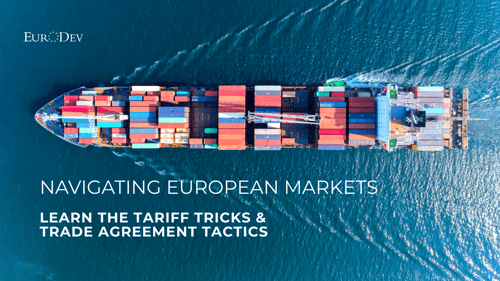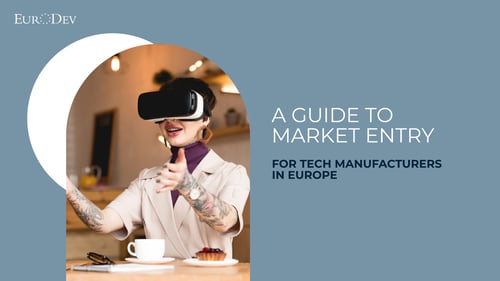Conquering the EU Market: Selling Software with Success
Software is all around us and has become a vital part of our lives. There are unlimited solutions for software applications. The European Software market represents one of the most powerful and most developed software markets in the world. It already credits to revenue of 146 billion USD in 2022. It is forecasted to reach almost 200 billion USD by the end of 2027, per Statista.
So, what is the magic trick? Why do some software companies sell successfully in Europe and others do not? In this blog, we'll explore effective strategies for North American companies to sell software in the European market.
Starting Points on Selling Software in Europe
One explanation is the highly diversified European market, with each country having unique and specific characteristics and challenges. Depending on how successful companies are in solving these challenges affects the prosperity of the market and how successfully companies are going to sell software in Europe.
Indirectly, it shows that these companies understand the need of the European software market and the proper way to communicate and approach selling their software in Europe.
Software Localization for the European Market
Localization is one of the most important challenges to face when entering the European market. Even though many European markets understand and widely use English, there are more than 40 European countries with at least one unique national language, and to succeed, it is necessary to communicate in the local language. That means that if a company wants to enter a certain national market in Europe, it will probably have to localize as much as possible.
People prefer to do business in their own language, and that is why localization is helping to connect to new prospects and customers. It shows dedication and an understanding of local needs, and it should help the company to connect more easily with the customer and sell software based on that. It may include:
Product
The product itself needs to be fully localized. The first thought is – translation. Although the translation of software is an important part, its localization does not begin there.
Software companies need to make sure their product fulfills the legal requirements of the market they want to enter and sell. Sometimes, they need to modify their product for a specific market to comply with all local regulations and needs. When these are set, then software companies should proceed with the translation of their product.
Support
For prospects and customers, local language experience only begins with the localization of the product because expectations for software companies are to provide full local language support.
From the sales experience through support and renewal teams, the idea is to provide a good local language experience to customers. This is not mandatory, but those that do it have a higher chance to provide a good experience to prospects and customers and, in the long term, to increase the revenue made in Europe.

Documentation
Some of the commonly overlooked aspects of communication are FAQs, instructions, manuals, brochures, and other documentation that follows selling software or its use in local markets.
Our recommendation would be to localize these as well to provide the necessary information in local languages. This will increase the chance of being widely accepted by people from local societies in Europe. It can also smooth the whole process because local cultures have specific phrases to be used in an explanation of the product and its benefits.
Marketing
While digital communication platforms are gaining more and more traction from prospects and customers, it would be wise to invest in adapting these to the needs of the local market.
For example, if you are going to focus on a different problem for the European market only and communicate based on that, you should build a separate website or landing page for the European audience.
Translation of the content is also a recommended step to take when entering the European market in order to bring it closer to this unique audience.
Currency
This is somewhat obvious, but it is commonly missed in expansion plans. Some EU countries are using the Euro as their currency, but many countries in Europe use their own currency as well. That means that if foreign software companies want to enter a certain market, they should adjust to the currency used in this specific market.

It is mainly focused on modifying the product pricing per local currency, setting the pricing strategy and how these are communicated to the local audience.
Read how Local Regulations are Shaping the US ERP Approach in the European Market.
VAT System for Software Companies in Europe
Here we need to segment the market into two main groups – software companies that are selling B2B digital products and those that are selling to B2C customers in Europe. Based on that, different VAT regulations are in use in European countries.
B2B software sales are not in the scope of the VAT system at all. On top of that, it does not matter where the company is coming from, it is the same for all companies selling B2B digital products or services to European customers. For B2C sales in Europe, it is a bit different because it will require you to register for the VAT MOSS scheme or register for VAT in each country in Europe where you plan to sell.
Anyhow, it is worth being aware that countries in Europe have different VAT and VAT regulations, so it will require you to be properly informed of the specific software market in Europe where you plan to sell.
Software Trademark Protection
In Europe, any company is allowed to protect the trademark, giving a company an exclusive right over distinctive signs – names, logos, colors, visuals etc. It helps the prospects to distinguish the brand and/or the product from competitors.
In most European countries, trademark protection lasts for 10 years, and then it can be renewed for as long as it needs.
Software trademark protection is an important way to secure an asset that can help the company grow by being recognized and thriving on brand loyalty that has been built through the years and many different channels.
Customer Habits in the European Software Market
It is common to say that in Europe, the buying decision is made based on numbers and data. That heavily affects the marketing and sales process of the software companies because they should be focused on these things when they communicate and try to sell to European customers.
Piracy level, the general level of digital literacy and the level of digitalization also play a key role for software companies when they are looking at the map of Europe and having a dilemma about which market to enter first.

There are differences between societies within Europe. It all results in various habits and a level of development of the market that may affect the sales of a software company trying to enter a market. That is why companies are usually trying to focus on one or couple of markets at the most and adjust all their efforts to the needs and habits of that market.
How to Sell Software in Europe Key Takeaways
Belief in entrepreneurship and adventurous behavior are an inspiration for foreign companies to enter the software market in Europe. Chances for success are big and optimistic since it is a fast-growing market that will continue to grow in the upcoming years. The humanity will rely more and more on software, so there is room for many companies to sell.
Still, in order to achieve sales and retention, these companies will have to solve the main challenges related to the expansion. Only then can they hope for a positive experience and an increase in income and revenue from the European software market.
Thus, partner with EuroDev for Sales Outsourcing solutions.
Bonus read: Unlocking Sales Potential in Europe for US Software Companies.
Category
Related articles
-

Guide: Navigating Tariffs and Trade Agreements in Europe
30 January 2024By understanding the market dynamics and optimizing tariff strategies manufacturers can position...
Read more -

Interview: Becoming a NATO supplier with Vicente Gonzalez
29 November 2023Vicente Gonzalez provides invaluable insights into the challenges and prospects for North American...
Read more -

Strategic Insights: Market Entry for North American Tech Manufacturers in Europe
29 November 2023Buckle up, because we're about to embark on a strategic journey to decode the keys to successful...
Read more

